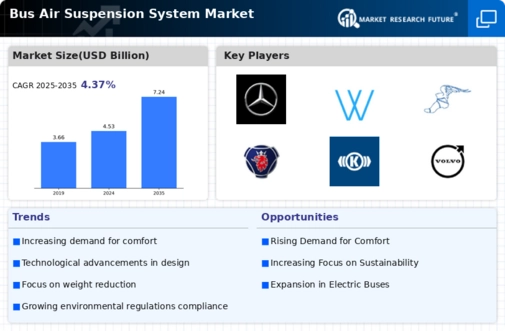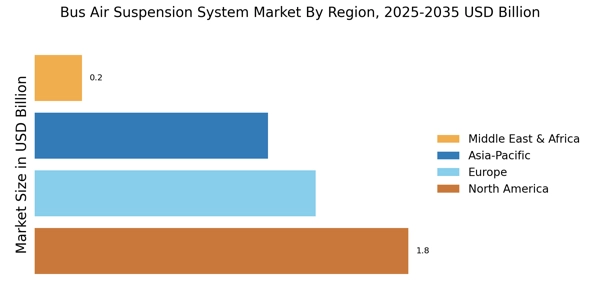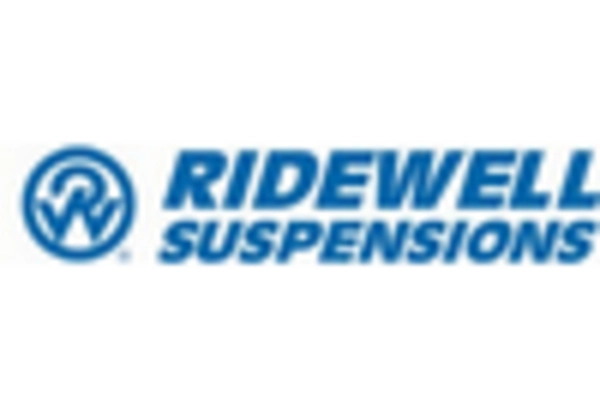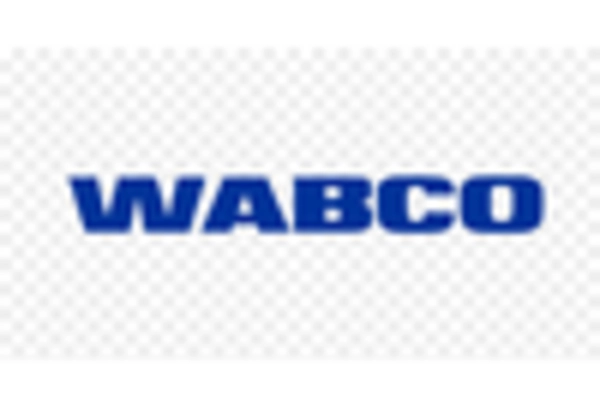Rising Competition and Innovation
The Bus Air Suspension System Market is characterized by rising competition among manufacturers, which is driving innovation and product development. As more companies enter the market, there is a heightened focus on creating advanced air suspension solutions that meet diverse customer needs. This competitive landscape encourages the development of systems that not only enhance ride quality but also integrate features such as self-leveling and load adjustment. Market analysis indicates that the introduction of innovative products is expected to increase market share for companies that can effectively differentiate their offerings. Additionally, partnerships and collaborations among manufacturers and technology providers are likely to foster further advancements in air suspension technology, thereby propelling the market forward.
Government Regulations and Support
The Bus Air Suspension System Market is also shaped by government regulations and support aimed at enhancing public transport infrastructure. Many governments are implementing policies that encourage the adoption of advanced technologies in public transport systems. These regulations often include incentives for operators to upgrade their fleets with modern air suspension systems, which are recognized for their benefits in safety and comfort. For instance, funding programs for public transport upgrades have been established in various regions, promoting the transition to more efficient vehicles. This support is likely to stimulate market growth, as operators seek to comply with regulations while improving service quality. The alignment of government initiatives with industry needs creates a favorable environment for the expansion of the bus air suspension system market.
Sustainability Initiatives in Public Transport
The Bus Air Suspension System Market is increasingly influenced by sustainability initiatives aimed at reducing the environmental impact of public transportation. As cities strive to meet stringent emissions regulations, the demand for eco-friendly transport solutions is on the rise. Air suspension systems contribute to this goal by improving fuel efficiency and reducing wear and tear on vehicles. Data indicates that buses equipped with air suspension systems can achieve up to 10% better fuel economy compared to traditional systems. This efficiency not only lowers operational costs but also aligns with the global push towards greener public transport solutions. Consequently, manufacturers are focusing on developing air suspension systems that utilize sustainable materials and technologies, further enhancing their appeal in the market.
Urbanization and Increased Public Transport Demand
The Bus Air Suspension System Market is significantly impacted by urbanization trends and the corresponding increase in public transport demand. As urban populations continue to grow, the need for efficient and comfortable public transport solutions becomes paramount. Air suspension systems are particularly well-suited for urban environments, where road conditions can be challenging. They provide a smoother ride, which is essential for passenger satisfaction. Recent statistics suggest that urban areas are witnessing a 20% increase in public transport usage, prompting operators to invest in modernized fleets equipped with advanced air suspension systems. This trend indicates a shift towards prioritizing passenger comfort and operational efficiency, thereby driving the growth of the bus air suspension market.
Technological Advancements in Bus Air Suspension Systems
The Bus Air Suspension System Market is experiencing a notable transformation due to rapid technological advancements. Innovations such as electronically controlled air suspension systems are enhancing ride quality and passenger comfort. These systems allow for real-time adjustments based on load conditions, which can lead to improved vehicle stability and safety. According to recent data, the adoption of advanced air suspension technologies is projected to increase by approximately 15% annually. This growth is driven by the need for enhanced performance and efficiency in public transport systems. Furthermore, the integration of smart technologies, such as IoT and telematics, is likely to provide operators with valuable insights into vehicle performance, thereby optimizing maintenance schedules and reducing operational costs.


















Leave a Comment